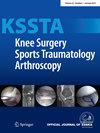Early MCID achievement is associated with better long-term outcomes following arthroscopy for femoroacetabular impingement
Abstract
Purpose
To determine whether early improvement is associated with long-term outcomes following arthroscopy for femoroacetabular Impingement and establish a threshold above which would indicate sustained improvement. It was hypothesised that those who display improvements early would report better long-term outcomes than those who did not report meaningful change at 1 year, allowing further targeted intervention where necessary.
Methods
An examination of patients (Tonnis 0,1) undergoing primary arthroscopy between January 2009 and March 2014, with 10-year review, was conducted. Four hundred and fifteen hip arthroscopy cases in 355 patients were included. The minimal clinically important difference (MCID) for the modified Harris Hip score (mHHS) at 1 year was calculated using the percentage of possible improvement (POPI) method. Patients were grouped as early improvers (EI) or non-improvers (NI) based on whether they achieved MCID at 1 year or not. Survival, revision rate, and the patient acceptable symptom state (PASS) were compared between groups using a Kaplan–Meier curve and chi-squared analysis.
Results
One year MCID achievement required an improvement from pre-operative mHHS of at least 47%; 79% of cases achieved MCID (EI), and 21% did not (NI). At 10 years, there were six total hip replacements in the EI group compared to 16 in the NI group (survival 98% vs. 82%, p < 0.001). Revision rates were lower in the EI group (6% vs. 12%, p = 0.005), and the EI group had higher levels of PASS achievement (86% vs. 68%, p < 0.001). Regression models indicated that MCID achievement at 1 year, reduced the odds of replacement and revision surgery while increasing the odds of PASS achievement at 10 years.
Conclusion
Higher survival rates, higher PASS rates and lower revision procedures were observed in EI. When accounting for other known confounding factors, improving by a minimum of 47% of what a patient could achieve in the mHHS at 1 year predicts superior outcomes long-term. For those patients failing to achieve this important improvement threshold, clinicians could consider introducing additional rehabilitation or interventions that may further improve recovery and potentially increase the likelihood of a better longer-term outcome.
Level of Evidence
Level IV.





 求助内容:
求助内容: 应助结果提醒方式:
应助结果提醒方式:


